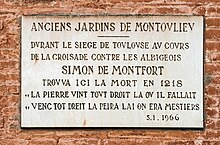Siege of Toulouse (1217–1218)
This article does not cite any sources. (October 2013) |
| Siege of Toulouse (1217–1218) | |||||||
|---|---|---|---|---|---|---|---|
| Part of the Albigensian Crusade | |||||||
 Depiction of Simon de Montfort's death at Toulouse | |||||||
| |||||||
| Belligerents | |||||||
|
|
| ||||||
| Commanders and leaders | |||||||
|
|
| ||||||
A Siege of Toulouse occurred from 22 September 1217 to 25 July 1218 during the Albigensian Crusade. It was third of a series of sieges of the city during the height of Crusader efforts to put down Catharism (and the local Languedocian nobility). It ended in the repulsion of the Crusaders and the death of their leader, Simon IV de Montfort.
Simon first besieged Toulouse in 1211, but failed to take it. In 1216 he captured the city and proclaimed himself Count of Toulouse, but while he was elsewhere, on 12 September 1217, the rival claimant, Raymond VI, retook the city without a fight. Simon returned in haste to besiege the city once more. Despite that he had ordered the city's defences dismantled while he was in control, he found its defences intact and its walls well-manned. His forces were too small to surround it and the siege dragged on through the winter months with little activity.

In the spring of 1218, a certain maestre (master) Bertran of Toulouse suggested to the people that they construct a trebuchet. The city's carpenters immediately took up the task. Meanwhile, on 3 June, the Crusaders constructed (or had brought in) a "cat" (a leather-covered, steeply-gabled mobile shelter) in order to approach the walls. The defenders' trebuchet swiftly dispatched it and, on 25 June, they sortied to burn the cat, which they did. During the Crusaders' counter-assault, Simon stopped to aid his brother Guy, who had been wounded by a crossbow, and was hit on the head by a stone from one of the defenders' siege engines (either the trebuchet or a mangonel), apparently operated by donas e tozas e mulhers (ladies, girls, and women). It killed him. The leadership of the Crusade fell to his son Amaury, but the siege was lifted a month later.
The events of the siege prompted the resident troubadour (and possibly priest) Raimon Escrivan to compose a song, Senhors, l'autrier vi ses falhida, on it. The song, a tenso, presents a mock debate between two siege machines (the trebuchet and the cat) in which the trebuchet wins.
Sources[]
- Guillaume de Puylaurens. The Siege of Toulouse in 1217–18. Cronica.
- Riquer, Martín de. Los trovadores: historia literaria y textos. 3 vol. Barcelona: Planeta, 1975.
- Conflicts in 1217
- Conflicts in 1218
- 1217 in Europe
- 1218 in Europe
- 1210s in France
- Albigensian Crusade
- Sieges of the Crusades
- Sieges involving France
- History of Toulouse
